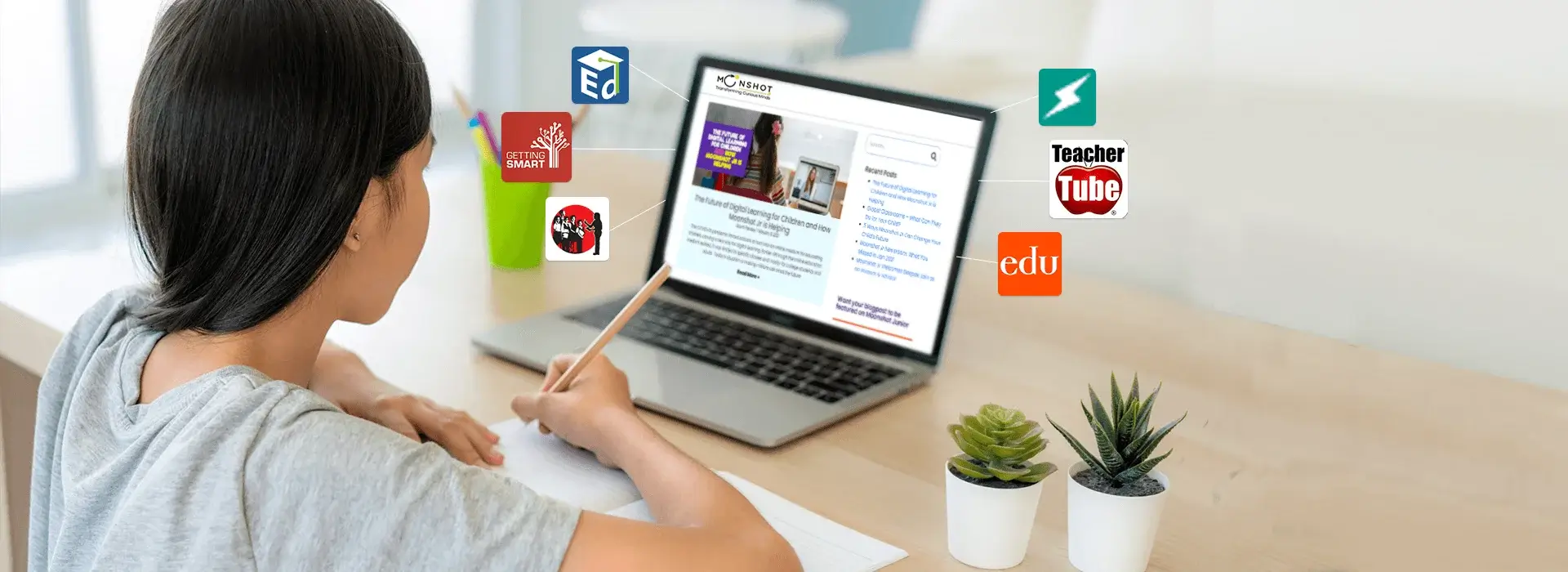
Update: This article was last updated on 10 December 2024 to reflect the accuracy and up-to-date information on the page.

Image Source: Mom.com
Virtual learning had existed for a while, but it hadn’t gained widespread acceptance. However, the shift to online learning for kids during the pandemic showcased how helpful, powerful, and far-reaching it could be. Once this transformation occurred, there was no going back.
The World Economic Forum (WEF) reports that over 1.2 billion children in 186 countries were affected by school closures caused by the pandemic, resulting in a significant transformation in education. Since the outbreak of COVID-19, there has been a marked increase in the usage of various educational technologies, such as language apps, virtual tutoring, video conferencing tools, and online learning software. This evolution has highlighted the pivotal role of online learning for kids in ensuring uninterrupted education and fostering new opportunities for growth.
Recommended reading: THE FUTURE OF VIRTUAL SURGERY WITH APOQLAR’S INNOVATIVE SOLUTIONS

Before the pandemic, education technology was experiencing growth and adoption, with global investments reaching $18.66 billion in 2019. Now, the online education market is projected to reach $350 billion by 2025, reports WEF.
| S.No. | Table of Contents |
|---|---|
| 1. | What is Virtual Learning |
| 2. | What Factors Contribute To The Industry’s Growth |
| 3. | Benefits of Virtual Learning For Kids |
What is virtual learning?

Virtual learning, a mode of education where students are taught by instructors who deliver lessons online through video or audio, empowers children to take control of their education. This instruction can occur either in a self-paced format or in real-time, offering flexibility and convenience. The advantages of virtual learning include enhanced accessibility for students who might face geographic or physical barriers, the ability to learn at their own pace, and a wider range of course options.
Additionally, virtual learning often reduces costs associated with commuting and traditional classroom infrastructure, making it a more affordable and independent option for many learners.
Image Source: Mom News Daily
What factors contribute to the industry’s growth?
Increased internet penetration worldwide is one factor contributing to the growth of virtual learning. The expanding telecom and broadband sector has also increased access to cost-effective international connectivity plans.
The advantages of virtual learning are further supported by data from the International Telecommunication Union (ITU), which reports strong global growth in Internet use, with an estimated 4.9 billion people using the Internet in 2021, up from 4.1 billion in 2019. Virtual learning enhances the educational experience by utilizing digital technology. It includes a wide range of tools, such as online courses, content platforms, etc., which help save both money and time.
There are many benefits of virtual learning for kids, but here are a few of the top ones:
1) Flexibility

Flexibility is a key feature of virtual learning because it allows students to study from anywhere in the world and complete assignments on their own time, which is especially beneficial for children who have busy or unconventional schedules.
Image Source: Australia.edu
2) Customized learning
Online education, with its virtual learning benefits, tailors the curriculum to the children’s needs, interests, skills, and strengths. This learning flexibility provides students with relevant learning resources, making it engaging and interesting. As a result, academic performance improves.
Recommended Reading: Nano Learning Future Trend In Education 2023
Image Source: 3P learning

3) Interactive learning

Online classes, often smaller than traditional classrooms, foster a sense of community. Most online learning platforms allow one student to participate at a time, promoting interaction and feedback between students and mentors. This sense of community enhances the benefits of online learning for students, making them feel connected and part of a larger educational network.
Image Source: Viewsonic
4) Self-paced learning
E-learning for Kids: Students can progress at their own pace in virtual learning, which can benefit children who need more time to understand certain concepts or are advanced learners. This means that a student can spend more time on a topic they find challenging, and move quickly through material they find easy. This flexibility allows personalized learning experiences tailored to individual needs, fostering a supportive and effective educational environment.
Image Source: Education worldwide

5) Access to a wider range of resources

Mentors can supplement their lessons with other formats such as forums or discussions. This extra content is accessible at all times and from any location, resulting in a more dynamic and personalized educational experience.
Image Source: Yourstory.com
6) Increased classroom engagement
Virtual learning often incorporates interactive and multimedia elements that can help keep children more engaged and motivated in their studies.
Image Source: Prodigy

7) Convenience

In virtual learning, the students do not have to travel to a physical location for instruction, which saves money and time. It also enables students to learn from the comfort of their own homes, increasing flexibility and convenience.
Image Source: Videohive
8) Increased safety
During pandemics such as COVID-19, virtual learning has been a safe way for children to continue their education without risking their health. This safety aspect of virtual learning provides reassurance and confidence to parents and educators, ensuring that children’s health is not compromised in their pursuit of education.
Image Source: Campus security today

Summing up
According to a McKinsey report, US venture funding for education technology (edtech) increased from $1 billion to $8 billion between 2017 and 2021. The public appetite for these investments was evident in the successful IPOs of several edtech companies in 2021, including Coursera (valued at more than $4 billion).
E-learning for kids has played a significant role in driving this growth, offering innovative platforms that enhance children’s education. Virtual learning provides:
- Numerous advantages for children.
- Enabling them to access tailored educational experiences.
- Interactive content.
- Opportunities for growth and development that they might not have in traditional settings.
The industry’s expansion and significant investments underscore its potential to shape the future of education.
Moonpreneur is dedicated to transforming conventional education, preparing the next generation with comprehensive learning experiences. Our Innovator Program equips students with vital skills in AI/ML, Robotics, Coding, Game Development, and App Development, fostering entrepreneurship through hands-on learning. This initiative aims to cultivate the workforce of tomorrow by integrating innovative technologies and practical skills in school curriculums.
Register for a 60-minute free workshop today!
















Is virtual learning as effective as classroom learning?
If you value flexibility and self-paced learning, online learning may be the right choice.
In my experience, face-to-face learning can never get outdated.
That’s true.. if you prefer personal interaction and practical learning, traditional classroom learning is always better fit.